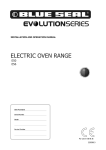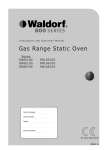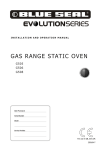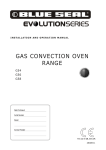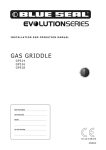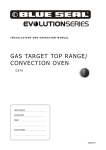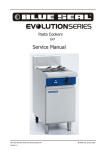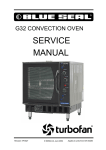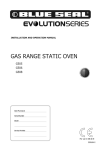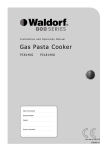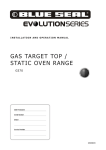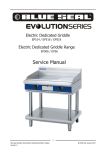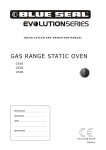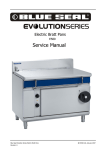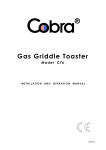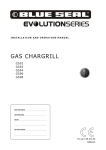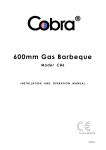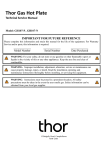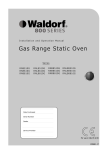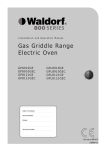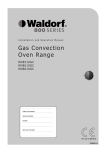Download Blue Seal G570 Specifications
Transcript
INSTALLATION AND OPERATION MANUAL GAS TARGET TOP / STATIC OVEN RANGE G570 For use in GB & IE 230096-2 Contents Blue Seal Gas Target Top Static Oven Range G570 Gas Target Top Static Oven Range. Introduction..............................................................................................2 Specifications............................................................................................3 Model Numbers Covered in this Specification General Gas Supply Requirements Gas Connection Dimensions................................................................................................5 Installation................................................................................................6 Installation Requirements Unpacking Location Clearances Assembly Gas Connection Commissioning Operation...................................................................................................9 Operation Guide Description of the Controls Lighting the Pilot Burner - (Target Top) Lighting the Main Burner - (Target Top) Lighting the Pilot Burner - (Oven) Oven - Main Burner / Thermostat Turning the Oven to ‘Stand-By’ (Pilot ‘ON’ Only) Oven ‘Shut Down’ Cleaning and Maintenance......................................................................12 General After Each Use Daily Cleaning Weekly Cleaning Periodic Maintenance Fault Finding............................................................................................14 Gas Conversion and Specifications.........................................................15 Conversion Procedure Gas Specifications Replacement Parts List...........................................................................20 1 Introduction We are confident that you will be delighted with your BLUE SEAL Target Top Gas Static Oven Range, and it will become a most valued appliance in your commercial kitchen. To ensure you receive the utmost benefit from your new Blue Seal appliance, there are two important things you can do. Firstly: Please read the instruction book carefully and follow the directions given. The time taken will be well spent. Secondly: If you are unsure of any aspect of the installation, instructions or performance of your appliance, contact your BLUE SEAL dealer promptly. In many cases a phone call could answer your question. CE Only: These instructions are only valid if the country code appears on the appliance. If the code does not appear on the appliance, refer to the supplier of this appliance to obtain the technical instructions for adapting the appliance to the conditions for use in that country. WARNING: IMPROPER INSTALLATION, ADJUSTMENT, ALTERATION, SERVICE OR MAINTENANCE CAN CAUSE PROPERTY DAMAGE, INJURY OR DEATH. R EAD THE INSTALLATION, OPERATING AND MAINTENANCE INSTRUCTIONS THOROUGHLY BEFORE INSTALLING OR SERVICING THIS APPLIANCE. WARNING: INSTRUCTIONS TO BE FOLLOWED IN THE EVENT THE USER SMELLS GAS ARE TO BE POSTED IN A PROMINENT LOCATION. THIS INFORMATION SHALL BE OBTAINED BY CONSULTING THE LOCAL GAS SUPPLIER. WARNING: GREAT CARE MUST BE TAKEN BY THE OPERATOR TO USE THE EQUIPMENT SAFELY TO GUARD IT AGAINST RISK OF FIRE. • • THE APPLIANCE MUST NOT BE LEFT 'ON' UNATTENDED. IT IS RECOMMENDED THAT A REGULAR INSPECTION IS MADE • DO NOT • BY A COMPETENT SERVICEMAN TO ENSURE CORRECT AND SAFE OPERATION OF YOUR APPLIANCE IS MAINTAINED. STORE OR USE GASOLINE OR OTHER FLAMMABLE VAPOURS OR LIQUIDS IN THE VICINITY OF THIS OR ANY OTHER APPLIANCE. DO NOT SPRAY AEROSOLS IN THE VICINITY OF THIS APPLIANCE WHILE IT IS IN OPERATION. C AUTION : This appliance is; • For professional use and is to be used by qualified persons only. • Only authorised service persons are allowed to carry out installation, servicing and gas conversion operations. • Components having adjustments protected (e.g. paint sealed) by the manufacturer should not be adjusted by the user/operator. • DO NOT operate the appliance without the legs supplied fitted. 2 Specifications Model Numbers Covered in this Specification G570 Gas Target Top Static Oven Range. General A commercial heavy duty, general purpose fully modular, gas fired Target Top Static Oven Range, having a high output, two stage double-ring iron cast burner offering accurate temperature control and infinitely variable heat with the heat radiating out from the centre of the Target Top. The Main Burner is located underneath removable cast target top plates. The Target Top is uses a 45 MJ/hr burner and as standard is fitted with full pilot, flame failure protection. The Oven utilizes a 30 MJ/hr oven main burner with pilot and flame failure protection and is fitted with piezo ignition to the oven pilot burner. The oven is controlled with a 80 to 300ºC thermostat. Access to the oven main and pilot burner is via a drop down door and a removable front lintel on the lower part of the oven. The appliance is built to facilitate easy cleaning and maintenance with all parts being front accessible once the appliance is installed. Gas Supply Requirements - Non UK Only Natural Gas Input Rate (N.H.G.C.) LP Gas (Propane) Target Top Oven Target Top Oven 45 MJ/hr (42,650 Btu/hr) 30 MJ/hr (28,435 Btu/hr) 45 MJ/hr (42,650 Btu/hr) 30 MJ/hr (28,435 Btu/hr) 1.13 - 3.40 kPa (4.5” - 13.5” w.c.) 1.0 kPa (*) (4.0” w.c.) Gas Supply Pressure Burner Operating Pressure 2.75 - 3.40 kPa (11” - 13.5” w.c.) 2.60 kPa (*) (10.0” w.c.) 3 Gas Connection /4” B.S.P. Male - UK Only Appliance Classification II 2H3P. Category: Flue Type: A1. Natural Gas (G20) Heat Input (nett) Gas Rate (nett) Nominal Reduced Nominal Reduced Target Top 11.5 kW 4.7 kW 1.22 m3/hr 0.50 m3/hr Supply Pressure Burner Operating Pressure Propane (G31) Oven 8.0 kW 2.4 kW 0.85 m 3/hr 0.25 m 3/hr Target Top 11.5 kW 7.9 kW 0.89 kg/hr 0.61 kg/hr 20 mbar Oven 8.0 kW 2.4 kW 0.62 m3/hr 0.19 m3/hr 37 mbar 9.9 mbar (*) 26.8 mbar (*) 3 Gas Connection /4” B.S.P. Male * The burner operating pressure is to be measured at the target top hob manifold test point with the target top burner (Inner and outer ring) operating at full setting. The operating pressure is ex-factory set through the appliance regulator and not to be adjusted, apart from when carrying out gas conversion, if required. (Refer to the details in this section for information). 3 Specifications Gas Connection Gas supply connection point is located 130mm from the right hand side, 32mm from the rear and 655mm from the floor and is reached from beneath the appliance. (Refer to the ‘Dimensions’ section). Connection is ¾" BSP male thread. 4 Dimensions G570 5 Installation Installation Requirements NOTE: • It is most important that this appliance is installed correctly and that operation is correct before use. Installation shall comply with local gas and health and safety requirements. • This appliance shall be installed with sufficient ventilation to prevent the occurrence of unacceptable concentrations of health harmful substances in the room, the appliance is installed in. Blue Seal Target Top Static Oven Ranges are designed to provide years of satisfactory service and correct installation is essential to achieve the best performance, efficiency and trouble-free operation. This appliance must be installed in accordance with National Installation Codes and in addition, in accordance with relevant National / Local Codes covering gas and fire safety. AUSTRALIA: NEW ZEALAND: Australia / New Zealand: UNITED KINGDOM: IRELAND: - AS 5601 - Gas Installations. - NZS 5261 - Gas Installation. - AS/NZS 3000 - Wiring Rules. - Gas Safety (Installation & Use) Regulations 1998. - BS 6173 - Installation of Catering Appliances. - BS 5440 1 & 2 - Installation Flueing & Ventilation. - BS 7671 - Requirements for Electrical Installation. - IS 820 - Non - Domestic Gas Installations. Installations must be carried out by authorised persons only. Failure to install equipment to the relevant codes and manufacturer’s specifications shown in this section will void the warranty. Components having adjustments protected (e.g. paint sealed) by the manufacturer are only allowed to be adjusted by an authorised service agent. They are not to be adjusted by the installation person. Unpacking • Remove all packaging and transit protection from the appliance including all protective plastic coating from the exterior stainless steel panels. • Check equipment and parts for damage. Report any damage immediately to the carrier and distributor. • Report any deficiencies to the distributor who supplied the appliance. • Check that the available gas and electrical supply is correct to that shown on the rating plate located behind the control panel, close to the gas control valve. Location 1. Installation must allow for a sufficient flow of fresh air for the combustion air supply. Combustion Air Requirements: Natural Gas LPG 12 2. 3. 4. 5. 6. 12 m3/hr m3/hr Installation must include adequate ventilation means, to prevent dangerous build up of combustion products. Never directly connect a ventilation system to the appliance flue outlet. Any gas burning appliance requires adequate clearance and ventilation for optimum and trouble-free operation. The minimum installation clearances shown below are to be adhered to. Position the appliance in its approximate working position. All air for burner combustion is supplied from beneath the appliance. The legs must always be fitted to the appliance and no obstructions placed on the underside or around the base of the appliance, as obstructions will cause incorrect operation and/or failure of the appliance. NOTE: Do not obstruct or block the appliance flue. Never directly connect a ventilation system to the appliance flue outlet. 6 Installation Clearances Left/Right Hand Side Rear Combustible Surface 50 mm 50 mm Non Combustible Surface 0 mm 0 mm NOTE: Only non-combustible materials can be used in close proximity to this appliance. Assembly NOTE: • All Models are delivered completely assembled. No further assembly is required. Refer to the information below for assembly instructions. • This appliance is fitted with adjustable feet to enable the appliance to be positioned securely and level. This should be carried out on completion of the gas connection. Refer to the 'Gas Connection' section. Optional Accessories (Refer to Replacement Parts List) • Plinth Kit. For installation details, refer to the instructions supplied with each kit. 1. 2. Check that all the feet (rollers) are securely fitted. Adjust the feet to make the Range steady and level. Gas Connection NOTE: ALL GAS FITTING MUST ONLY BE CARRIED OUT BY AN AUTHORISED PERSON. 1. 2. Blue Seal Target Top Oven Ranges do not require an electrical connection, as they function totally on the gas supply only. It is essential that the gas supply is correct for the appliance to be installed and that adequate supply pressure and volume are available. The following checks should therefore be made before installation:a. Gas Type the appliance has been supplied for is shown on the coloured stickers located above the gas connection and next to the rating plate. Check that this is correct for the gas supply the appliance is being installed for. The gas conversion procedure is detailed in this manual. b. Supply Pressure required for this appliance is shown in the “Specifications” section of this manual. Check the gas supply to ensure that adequate supply pressure exists. Rating Plate c. Input Rate of this appliance is stated on the Rating Plate and in the “Specifications” section of this manual. The input rate should be checked against the available gas supply line capacity. Particular note should be taken if the appliance is being added to an existing installation. Fig 1 NOTE: It is important that adequately sized piping runs directly to the connection joint on the appliance with as few tees and elbows as possible to give maximum supply volume. 3. Fit the gas regulator supplied, into the gas supply line as close to the appliance as possible. NOTE: The gas pressure regulator provided with this appliance is convertible between Natural Gas and LPG and is already converted ex-factory to the gas type labelled beside the gas connection point. The regulator outlet pressure is fixed ex-factory and it is NOT to be adjusted. The regulator connections are 3/4" BSP female. The connection to the appliance is 3/4" BSP male. (Refer to the “Specifications” section for the gas supply location dimensions). 7 Installation NOTE: A Manual Isolation Valve must be fitted to the individual appliance supply line. 4. 5. 6. Correctly locate the appliance into its final operating position and using a spirit level, adjust the legs so that the appliance is level and at the correct height. Connect the gas supply to the appliance. A suitable joining compound which resists the breakdown action of LPG must be used on every gas line connection, unless compression fittings are used. Check all gas connections for leakages using soapy water or other gas detecting equipment. WARNING: DO 7. NOT USE A NAKED FLAME TO CHECK FOR GAS LEAKAGES . Check that the gas operating pressure is as shown in the “Specifications” section. Low Fire Adjustment Screw NOTE: The operating pressure to be measured at the manifold test point and with the burners operating at the “High Flame” setting. 8. 9. 10. Turn off the mains gas supply and bleed the gas out of the appliance gas lines. Turn ‘ON’ the gas supply and the appliance. Verify the operating pressure remains correct. Manifold Pressure Test Point Fig 2 Commissioning Before leaving the new installation; Check the following functions in accordance with the operating instructions specified in the “Operation” section of this manual. • Light the Target Top Pilot Burners. • Light the Target Top Main Burners. • Light the Oven Pilot and Main Burners. • Check the Oven Main Burner Thermostat operation. • Check the Low Fire Burner operation for Target Top and Oven. • Check the High Fire Burner operation for Target Top and Oven. Ensure that the operator has been instructed in the areas of correct lighting, operation, and shutdown procedure for the appliance. This manual must be kept by the owner for future reference, and a record of Date of Purchase, Date of Installation and Serial Number of Appliance recorded and kept with this manual. (These details can be found on the Rating Plate attached to the lower right hand side of the sill panel. Refer to the “Gas Connection” section). NOTE: If for some reason it is not possible to get the appliance to operate correctly, shut off the gas supply and contact the supplier of this appliance. 8 Operation Operation Guide C AUTION : • This appliance is for professional use and is only to be used by qualified people. • Only authorised service persons should be used to carry out installation, servicing or gas conversion operations. • Components having adjustments protected (e.g. paint sealed) by the manufacturer should not be adjusted by the user/operator. 1. 2. Blue Seal appliances have been designed to provide simplicity of operation and 100% safety protection. Improper operation is therefore almost impossible, however bad operation practices can reduce the life of the appliance and produce a poor quality product. To use this appliance correctly please read the following sections carefully:• Lighting the Pilot Burner. • Lighting the Main Burner. • Oven Pilot Ignition. • Oven Main Burner / Thermostat. • Turning Oven to ‘Stand-By’ Mode. • Oven ‘Shut-Down’. Description of the Controls Target Top Gas Control Knob OFF Position PILOT Burner HIGH Flame LOW Flame Oven Temperature Controller Oven Option OFF Position Pilot Burner Viewing Hole PILOT Burner Temperature Graduations 100°C to 290°C Piezo Igniter (Oven) Fig 3 9 Operation Lighting the Pilot Burner - (Target Top) 1. Remove centre casting with the casting removal tool. 2. Depress the control knob and rotate anti-clockwise to the ‘PILOT’ position. 3. With the control knob depressed, manually light the pilot burner located in front of the main burner. 4. Hold in the control knob for approximately 10 to 15 seconds, then release. 5. The pilot burner should remain alight. If not repeat Items 2 to 4 above until the pilot burner lights. Lighting the Main Burner - (Target Top) 1. Ensure that pilot burner is alight by checking through the hole in the centre of the front control panel or by removing the centre casting with casting removal tool. 2. Rotate the gas control knob anti-clockwise to the position marked ‘HIGH’. 3. The main burner will now ignite automatically off the pilot burner. 4. Once lit the main burner will be burning at full rate. For a lower heat turn the gas control knob fully anti-clockwise to the ‘LOW’ position. 5. Also for intermediate heat, position the gas control knob between the ‘HIGH’ and ‘LOW’ positions. NOTE: Always set the gas control knob to the ‘HIGH’ position when lighting the main burner. If the pilot burner goes out during normal operation wait 5 minutes before relighting. 6. The cast iron work surface has a heat pattern that can be used effectively by positioning cooking pans etc. appropriately according to heat requirement. 200 / 250 250 / 300 300 / 350 350 / 400 Fig 4 Heat Pattern for target top on full heat (°C) 150 / 200 200 / 250 250 / 300 Fig 5 Heat Pattern for target top on Low Heat (°C) 10 Operation Lighting the Pilot Burner - (Oven) This oven is fitted with a pilot as a standard option and Flame Failure Protection, which is incorporated by way of a thermo-electric system for the main burner. Flame Failure Protection will shut off the gas supply to the burner in the event that the pilot burner goes out, so that un-burnt gas is not expelled. This is an . important safety feature which is slowly becoming law throughout the world ! IMPORTANT 1. 2. 3. 4. 5. DO NOT USE aluminium foil or trays directly on the cast iron sole plate(s). NEVER block or cover the openings on each side of the sole plate(s). Open the oven door. Depress the oven temperature control knob and rotate anti-clockwise to the ‘PILOT’ position. While holding the oven temperature control knob depressed, press the piezo ignition button to ignite the pilot burner. Repeat Items 1 and 2 until the oven pilot is lit. View the oven pilot burner is alight by checking through the pilot viewing holes checking through the hole in the front of the sole plate with the oven door open. Release the gas control knob approximately 10-20 seconds after lighting the pilot. The pilot should now remain alight - if not, repeat Steps 2 to 3 above. Pilot Burner Fig 6 Oven - Main Burner / Thermostat 1. 2. With the pilot burner alight, rotate the thermostat control knob on the front control panel to the desired oven temperature setting required, this will regulate the gas supply to the oven main burner. To turn the oven main burner “OFF”, simply turn the thermostat control knob to the “OFF” position. Turning the Oven to ‘Stand-By’ (Pilot ‘ON’ Only) 1. 2. To turn off the oven burner / heating, set the oven thermostat to the ‘PILOT’ position, this will turn the oven ‘OFF’, but will leave the oven pilot burner ‘ON’. In this position the pilot burner will remain alight, but the oven main burner will not operate until the thermostat control knob is set to a temperature. If preheating the oven is required, set the thermostat control knob to temperature 190°C and allow 20 minutes before cooking in the oven to allow the oven to warm up. Oven ‘Shut-Down’ 1. To ‘Shut Down’ the oven, turn the thermostat control knob to the ‘OFF’ position. This will turn ‘OFF’ the oven and extinguish the oven pilot burner. To relight the oven pilot burner, refer to “Lighting the Pilot Burner (Oven)” above. 11 Cleaning and Maintenance CAUTION: Always turn 'Off' the gas supply before cleaning. This appliance is not water proof. Do not use water jet spray to clean interior or exterior of this appliance. General Clean the Target Top regularly. A clean appliance looks better, will last longer and will perform better. Carbonised grease on the cooking surface will hinder the transfer of heat from the cooking surface to the food. This will result in loss of cooking efficiency. DO NOT use water on the Target Top while this item is still hot as warping and cracking may occur. Allow the Target Top to cool down before cleaning. NOTE: • DO NOT use abrasive detergents, sharp scrapers, strong solvents or caustic detergents as they could corrode or damage the Target Top / Range. • In order to prevent the forming of rust on the Target Top, ensure that any detergent or cleaning material has been completely removed after each cleaning. The appliance should be switched on briefly to ensure the Target Top becomes dry. To keep your Target Top clean and operating at peak efficiency, follow the procedures shown below:After Each Use Clean the Target Top with a stiff nylon brush or a flexible spatula to remove any build up of carbon. Daily Cleaning 1. 2. 3. 4. Thoroughly clean the splash back, the interior and exterior surfaces of the Target Top / Range with hot water, a mild detergent solution and a soft scrubbing brush. Brush the Target Top (cast iron) with a soft bristled brush followed by wiping with a cloth to prevent accumulation of carbon. Remove the drip tray and clean with a mild anti bacterial detergent and hot water solution using a soft bristled brush. Dry the drip tray thoroughly with a dry cloth. Dry the Target Top / Range thoroughly with a dry cloth and polish with a soft dry cloth. Weekly Cleaning NOTE: • If the Target Top / Range usage is very high, we recommend that the weekly cleaning procedure is carried out on a more frequent basis. • Ensure that protective gloves are worn during the cleaning process. • DO NOT use harsh abrasive detergents, sharp scrapers, strong solvents or caustic detergents as they will damage the Target Top / Range. • DO NOT use water on the Target Top / Range while it is still hot as warping may occur. Allow the castings to cool down before cleaning. Target Top a. This should be kept clean of any build up of spillage’s of food. Provided the cast iron work surface is regularly used it will maintain itself in good condition with no special cleaning requirements being necessary. b. Clean any food residue and spillage from the channels around the centre casting and main plates before use. 12 Cleaning and Maintenance c. DO NOT use water on the castings while they are still hot as cracking may occur. Should it be necessary to clean the castings, allow the castings to cool and then remove for cleaning. Clean using a soft cloth moistened with a mild detergent and hot water solution and a scrubbing brush. Dry thoroughly with a dry cloth. d. Remove the drip tray and clean with a mild anti bacterial detergent and hot water solution using a soft bristled brush. Dry the drip tray thoroughly with a dry cloth. Oven Interior a. Do not use wire brushes, steel wool or other abrasive materials to clean the oven interior. b. Clean the oven regularly with a good quality domestic oven cleaner. c. Once a week, remove and clean any built up of grease etc. from the oven racks and the bottom spill over cover. Stainless Steel Surfaces a. Clean the exterior surfaces of the target top / range with hot water, a mild detergent solution and a soft scrubbing brush. Note that the gas control knobs are a push fit onto the gas control valve spindles and can be removed to allow cleaning of the front control panel. b. Baked on deposits or discolouration may require a good quality stainless steel cleaner or stainless steel wool. Always apply cleaner when the appliance is cold and rub in the direction of the grain. c. To remove any discolouration, use an approved stainless steel cleaner or stainless steel wool. Always rub in the direction of the grain. d. Remove the drip trays and clean with a mild anti bacterial detergent and hot water solution using a soft bristled brush. Dry the drip trays thoroughly with a dry cloth before re-fitting. e. Dry all components thoroughly with a dry cloth and polish with a soft dry cloth. Periodic Maintenance NOTE: All maintenance operations should only be carried out by a qualified service person. To achieve the best results cleaning must be regular and thorough and all controls and mechanical parts should be checked and adjusted periodically by a qualified service person. If any small faults occur, have them attended to promptly. Don't wait until they cause a complete breakdown. It is recommended that the appliance is serviced every 6 months. Gas Control Valve Re-Greasing The gas control valve should be dismantled and greased every 6 months to ensure the correct operation of the gas control valve. To carry out this operation;a. Remove the gas control knobs from the gas tap spindles by pulling the knobs away from the control panel. b. Remove the drip tray from the appliance. c. Remove the two screws on the underside of the control panel, securing the control panel to the hob. d. Remove the control panel from the front of the appliance. e. Remove the 2 screws holding shaft plate to gas control body and remove control shaft and plate. (See Fig 7). Note orientation of shaft for correct re-assembly. f. Using needle nose pliers or similar, pull out gas control spindle, again noting its orientation. g. Apply a suitable high temperature gas cock grease or lubricant such as ROCOL - A.S.P (Anti scuffing paste)/ Dry Moly Paste to the outside of spindle. (See Fig 8). h. Replace spindle and re-assemble the gas control in reverse order. i. Refit the control panel to the appliance and secure with 2 screws. j. Refit the knobs to the gas control valve spindles. 13 Two Screws Spindle Fig 7 Fig 8 Fault Finding This section provides an easy reference guide to the more common problems that may occur during the operation of your appliance. The fault finding guide in this section is intended to help you correct, or at least accurately diagnose problems with your appliance. Although this section covers the most common problems reported, you may encounter a problem not covered in this section. In such instances, please contact your local authorised service agent who will make every effort to help you identify and resolve the problem. Please note that the service agent will require the following information:• The Model Trade Name and the Serial Number of the Appliance. (Both can be found on the Technical Data Plate located on the appliance). Fault Pilot won’t light. Pilot goes out when gas control knob released. Possible Cause Remedy No gas supply. Ensure gas isolation valve is turned on, and that bottles are not empty. Blocked pilot injector. Call the service provider. Releasing knob before the thermocouple has heated. Hold knob in for at least 20 seconds following ignition of the pilot. Pilot flame too small. - Gas pressure too low. - Partially blocked pilot injector. Clean or replace the pilot injector. Thermocouple connection to the gas control is loose or faulty. Tighten the thermocouple connection. Thermocouple faulty. Check that the thermocouple is producing between 20-30mV. Electromagnet in the rear of the gas control unit is faulty. Inspect and replace if not in good working order. Call the service provider. Main burner will not light. Piezo Ignition spark is being generated but not sparking from the ignition electrode to the pilot burner hood. Incorrect supply pressure. Call the service provider. Faulty gas control. Call the service provider. HT lead damaged or broken. Repair or replace the HT lead. Check that the ignition electrode is not cracked and is correctly positioned. Re-position or replace the ignition electrode. Piezo igniter faulty. Replace the piezo igniter. Call the service provider. NOTE: Components having adjustments protected (e.g. paint sealed) by the manufacturer, are only to be adjusted by an authorised service agent. They are not to be adjusted by an unauthorised service person. 14 Gas Conversion and Specifications Conversion Procedure CAUTION: Ensure that the Unit is isolated from the gas supply before commencing servicing. NOTE: • These conversions should only be carried out by qualified persons. All connections must be checked for leaks before re-commissioning the appliance. • For all relevant gas specifications refer to the ‘Specifications’ table at the end of this section. Target Top - Main Burner 1. 2. 3. 4. 5. 6. 7. Remove the control knob from the front control panel. The control knob is a push fit onto the shaft of the gas control valve. Remove the front control panel by slackening the 2 screws on the underside of the front control panel and remove the panel from the front of the target top. Remove the centre casting using the casting removal tool. Remove the 2 half plate castings to reveal the main burner. Remove the 2 front fire bricks and the right hand main fire brick. Unscrew and remove the 2 screws and washers securing the main burner to the target top. Carefully remove the main burner from the target top to reveal the inner and outer ring injectors. Burner Securing Screws Fig 9 Main Burner Injectors Pilot Burner Target Top - Main Burner Injector 1. 2. 3. 4. Unscrew the main burner injectors ( ½” A/F) from the Target Top. Determine the correct injector sizes for the corresponding gas from the rating plate affixed to the right hand front corner of the bottom sill. Replace with the correct size injectors (Note the injector size difference between inner and outer burner rings). Refit the main burner to the target top and secure in place with 2 screws and washers. Fig 10 Rating Plate NOTE: Ensure that the main burner is pulled fully towards the front of the unit prior to tightening the 2 main burner securing screws. Fig 11 X LH 15 OUTER RING Set the burner mixer screws for correct gas type aeration, as shown in the “Gas Specifications” table. INNER RING 5. RH Y Fig 12 Gas Conversion and Specifications Target Top - Pilot Burner 1. 2. 3. 4. 5. 6. To remove the pilot burner, disconnect the gas supply tube from the base of the pilot burner. Remove the bolt securing the retaining plate holding the pilot burner and thermo couple to the mounting bracket. Remove the retaining plate. The pilot burner can now be removed from the mounting bracket. Unscrew the base nut from the pilot burner and withdraw injector and spring from inside the pilot burner. Determine the correct injector size for the corresponding gas from the rating plate affixed to the right hand front corner of the target top next to the gas control valve. Re-assemble the pilot burner to the retaining bracket ensuring that the ports in the pilot burner are at the same height as the thermo-couple. Secure the pilot burner and thermocouple to the bracket with the retaining plate and securing screw. Pilot Burner Main Burner Injectors Gas Supply Tube Fig 13 Pilot Burner Thermocouple Main Burner Ignition Port NOTE: Ensure that the pilot burner and thermocouple are correctly located and that the pilot burner aligns with the main burner ignition port. (Refer to the Figures 12 & 13 for correct fitting and alignment dimensions). 7. 8. 9. 10. 11. Re-connect the gas supply tube to the base of the pilot burner. Refit the right hand main fire brick and the 2 front fire bricks to the target top. Refit the 2 half plate castings to the target top, ensuring that they correctly interlock once fitted. Refit the centre casting using the casting removal tool. Refit the front control panel and tighten the 2 screws on the underside of the front control panel to secure the panel in place. Refit the control knob to the front control panel. The control knob is a push fit onto the shaft of the gas control valve. Fig 14 Thermocouple Pilot Burner 18± 2.0 Main Burner Ignition Port 2± 2.0 Fig 15 Low Fire Adjustment (Target Top) 1. Set the burner low fire adjustment. The low fire screw on the gas control valve should be screwed fully in, then unscrewed by the measurement shown in the “Gas Specifications” table at the end of this section. Low Fire Adjustment Screw NOTE: The “Low Fire Screw” should be sealed with coloured paint on completion of the low fire adjustment. Fig 16 16 Gas Conversion and Specifications Oven 1. 2. 3. 4. 5. 6. 1. 2. 3. 4. 5. Injector: With the gas supply turned off at the main supply, unscrew and remove the 6 screws securing the lower lintel to the front of the oven. Open the oven door and remove the vitreous enamelled tray from inside the oven. Remove the 2 screws securing the oven burner in the oven and remove the main burner from the oven. The main injector will now be exposed and can be 1/ unscrewed and removed using a 13mm ( 2” A/F) spanner. Remove the main injector and replace with the correct size injector. (Refer to the ‘Gas Specifications’ table at the rear of this section). Refit the main burner to the oven and secure in position with the 2 screws. Pilot: To remove the oven pilot injector, from inside the oven, unscrew and remove the thermocouple and piezo igniter from the mounting bracket. Unscrew the hex nut holding the pilot supply tube to the rear of the pilot assembly. Withdraw the pilot injector from the pilot assembly. Replace the pilot injector with the correct sized injector for the gas type being used and re-connect the pilot supply tube to the pilot assembly. Refit the vitreous enamelled tray to the oven. Shown with door removed for ease of viewing 6 screws Fig 17 Main Injector Thermocouple Fig 18 Pilot Assembly Piezo Igniter Pilot Supply Line 1. 2. 3. 4. 5. Low Fire: To change the thermostat ‘Low Fire’ screw for the gas type required, remove the gas control knob from the oven control panel. The control knob is a push fit onto the shaft of the oven gas control valve. Remove the gas control knob. Unscrew the single screw at the top of the oven control panel, securing the panel and rotate rearwards and lift the panel away from the oven. Unscrew and remove the old ‘Low Fire’ screw from the lower left hand front of the valve and fully screw in the new ‘Low Fire’ screw for the new gas type. (Refer to the ‘Gas Specifications’ table at the rear of this section for screw types). Close the control panel and secure with the securing screw. Refit the oven gas control knob to the spindle of the oven gas control valve. Fig 19 Low Fire Screw Add Shot of Low Fire Adjustment point Fig 20 Fig 15 17 Gas Conversion and Specifications Gas Regulator NOTE: The regulator supplied is convertible between Natural Gas and LPG, but it’s outlet pressure is fixed ex-factory and is NOT to be adjusted. NOTE, Pin rotated for Natural Gas NOTE, Pin rotated for LPG Fig 21 1. 2. 3. 4. Ensure that the gas supply is turned ‘OFF’ at the mains. Unscrew the hexagonal cap (23mm A/F) from the regulator. Un-clip the plastic pin from the cap, rotate the pin and re-fit it back to the cap the correct way for the gas type to be used. (Either ‘LP’ or ‘NAT’ should be visible on the flank of the pin once re-fitted to the cap). Screw the cap back into the regulator. Gas Type Identification Label On completion of the gas conversion, replace gas type identification labels, located:- At the rear of the appliance, above the gas connection. - Beside the Rating Plate. Commissioning Before leaving the converted installation; 1. Check all gas connections for leakages using soapy water or other gas detecting equipment. WARNING: DO NOT USE A NAKED FLAME 2. TO CHECK FOR GAS LEAKAGES. Check the following functions in accordance with the operating instructions specified in the “Operation” section of this manual. • Light the Target Top Pilot Burner. • Light the Target Top Main Burner. • Check the Low Fire burner operation for Target Top and Oven. • Check the High Fire burner operation for Target Top and Oven. • Check the Oven Main Burner Thermostat operation. • Ensure that all the controls operate correctly. • Ensure that the operating pressure remains correct. NOTE: If for some reason it is not possible to get the appliance to operate correctly, shut off the gas supply and contact the supplier of this appliance. 18 Gas Conversion and Specifications Gas Specifications - Non-UK Only Nat. Gas Target Top Oven LP Gas (Propane) Main Burner Injector (Inner Ring) Ø 1.70 mm Ø 1.10 mm Main Burner Injector (Outer Ring) Pilot Burner Injector Burner Aeration Screw X (Inner) Burner Aeration Screw Y (Outer) Low Fire Adjustment Main Burner Pilot Burner Low Fire Screw Ø 2.60 mm 0.35 25 mm 28 mm 2½ turns out (ccw) Ø 2.60 mm 0.35 Ø 1.5 mm Ø 1.55 mm 0.25 25 mm 28 mm 1 turn out (ccw) Ø 1.60 mm 0.23 Ø 0.95 mm 1.00 kPa (*) 2.60 kPa (*) Burner Operating Pressure Gas Regulator Cap Screw - UK Only Appliance Classification Category: Flue Type: II 2H3P. A1. Natural Gas (G20) Target Top Main Burner Injector (Inner Ring) Ø 1.70 mm Ø 1.10 mm Main Burner Injector (Outer Ring) Ø 2.60 mm Ø 1.55 mm 0.35 0.25 25 mm 20 mm 28 mm 25 mm 2 /2 turns out (ccw) 1¾ turn out (ccw) Main Burner Ø 2.60 mm Ø 1.60 mm Pilot Burner 0.35 0.23 Ø 1.5 mm Ø 0.95 mm 9.9 mbar (*) 26.8 mbar (*) Pilot Burner Injector Burner Aeration Screw X (Inner) Burner Aeration Screw Y (Outer) 1 Low Fire Adjustment Oven Propane (G31) Low Fire Screw Operating Pressure Gas Regulator Cap Screw * The burner operating pressure is to be measured at the target top hob manifold test point with the target top burner (inner and outer ring) operating at full setting. The operating pressure is ex-factory set through the appliance regulator and not to be adjusted, apart from when carrying out gas conversion, if required. (Refer to the details in this section for information). 19 Replacement Parts List Replacement Parts List IMPORTANT: Only genuine authorized replacement parts should be used for the servicing and repair of this appliance. The instructions supplied with the parts should be followed when replacing components. For further information and servicing instructions, contact your nearest authorized service branch (contact details are as shown on the reverse of the front cover of this manual). When ordering replacement parts, please quote the part number and the description as listed below. If the part required is not listed below, request the part by description and quote model number and serial number which is shown on the rating plate. Target Top Controls 228853 230511 019429 017800 227378 031170 031260 031110 031155 227985 227984 Burner. Pilot Burner. Thermocouple. Gas Control Valve. Gas Control Knob. Injector Inner Ring Injector Outer Ring Injector Inner Ring Injector Outer Ring Pilot Injector (Nat Pilot Injector (LPG) (Nat Gas) (Nat Gas) (LPG) (LPG) Gas) 1.70 mm. 2.60 mm. 1.10 mm. 1.55 mm. 0.35 mm. 0.25 mm. Regulator 228531 Regulator (RV48CLM) - (Nat Gas / LPG - convertible) - ¾” BSP F/F. 228767 018691K 020253 018743 032260 032160 026488 019217 228703 227381 022408 022407 227508 Piezo 019407 Oven Burner. Oven Pilot. Oven Thermocouple. Thermocouple Spacer. Oven Burner Injector (Nat Gas) Oven Burner Injector (LPG) Pilot Injector (Nat. Gas) Pilot Injector (LPG) Thermostat / Gas Control Kit. Knob Thermostat 100-290°C. Low Fire Screw (Nat. Gas) Low Fire Screw (LPG) Ignitor. H.T Lead. Oven 20 2.60 1.60 0.35 0.23 mm. mm. mm. mm. 1.50 mm. 0.95 mm. Replacement Parts List General 227012 227013 014997 227892 227893 227896 227850 229674 Centre Half Oven Rear Casting. Plate Casting. Casting Removal Tool. Oven Side Rack LH. Oven Side Rack RH. Rack. Adjustable Leg (150 mm) Roller Assy. Accessories 228800 Ranges 900 mm Plinth Kit. Utensils Direct 0845 873 6600 www.utensilsdirect.co.uk 21






















